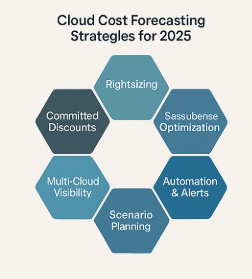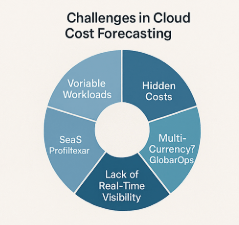
The era of digital transformation has pushed businesses to rely heavily on cloud services and SaaS applications for operational efficiency, scalability, and innovation. While this shift has unlocked enormous value, it has also introduced a critical challenge: managing and forecasting cloud costs. Inconsistent workloads, unpredictable demand spikes, and multi-cloud environments make budget planning increasingly complex. To build a stronger foundation in cloud concepts, see our comprehensive guide to cloud computing terminology.
By 2025, enterprises are moving beyond traditional cost tracking toward predictive analytics for cloud cost forecasting, leveraging AI/ML models, historical data, and real-time insights to optimize budgets. This article explores how organizations can adopt predictive analytics to achieve accurate budget planning, reduce financial risks, and maximize ROI in cloud and SaaS ecosystems.
Why Cloud Cost Forecasting Matters in 2025
Cloud adoption has surged across industries, with Gartner estimating global public cloud spending to eCloud adoption has surged across industries, with Gartner estimating global public cloud spending to exceed $1 trillion by 2027. As businesses migrate more workloads to AWS, Azure, and Google Cloud, the complexity of billing and cost distribution grows.
- Dynamic Pricing Models: Cloud providers use pay-as-you-go pricing, reserved instances, spot pricing, and committed use discounts. Predicting future costs without analytics is nearly impossible.
- Multi-Cloud and Hybrid Environments: Enterprises rarely rely on a single vendor. Instead, they distribute workloads across AWS, Azure, GCP, and SaaS vendors, complicating financial oversight.
- Economic Pressures: Recessionary trends and rising IT budgets demand cost predictability, ensuring CFOs and CIOs can plan accurately for 2025 and beyond.

In addition, regulatory requirements and financial reporting standards are putting extra pressure on organizations to provide transparent cost projections. Companies in sectors like finance, healthcare, and government must demonstrate compliance and avoid unpredictable budget overruns that could impact audits. Furthermore, as businesses increasingly adopt AI-driven services, edge computing, and high-performance workloads, the scale of cloud consumption grows exponentially. Without forecasting models, such usage spikes can derail strategic investments, reduce profitability, and strain relationships between IT and finance teams. In short, forecasting in 2025 is not just about predicting expenses—it is about ensuring long-term business continuity, compliance, and strategic resilience.
Challenges in Cloud Cost Forecasting
Accurately predicting cloud costs is more complicated than it seems. Several challenges persist:

1. Variable Workloads and Elastic Scaling
Cloud’s elasticity is both a benefit and a challenge. Workloads fluctuate with seasonality, product launches, or user behavior. Without predictive modeling, finance teams often underestimate or overestimate budgets. Even a single marketing campaign or product update can trigger an unexpected surge in compute or storage needs. The ability to forecast these sudden changes is still limited by traditional financial models that don’t account for non-linear growth.
2. Hidden and Indirect Costs
Beyond compute and storage, organizations face hidden costs such as data egress fees, API calls, inter-region traffic, and compliance expenses. These are rarely accounted for in traditional budgeting. For example, moving data between regions for analytics or AI training can cause sudden, steep charges. When multiplied across multiple business units, these overlooked costs create massive forecasting inaccuracies.
3. SaaS Proliferation
Modern enterprises use hundreds of SaaS applications. While individually affordable, collectively they inflate IT spend. Subscription overlaps, unused licenses, and renewal mismanagement contribute to poor forecasting. What’s more, SaaS vendors frequently update pricing models or bundle new features, making historical cost comparisons less reliable and complicating future estimates.
4. Multi-Currency and Global Operations
For companies operating across multiple regions, cost forecasting must include currency fluctuations, tax implications, and regional pricing models. These external economic factors are hard to model, yet they have a direct impact on IT budgets. A spike in foreign exchange rates, for instance, could make projected costs in one region significantly higher than expected, disrupting financial planning.
5. Lack of Real-Time Visibility
Traditional financial reporting is reactive, not proactive. By the time finance teams review costs, budgets may already be exceeded. Predictive analytics closes this gap by offering real-time and forward-looking insights. However, many organizations still operate with siloed reporting tools that do not integrate well across multi-cloud or SaaS ecosystems, limiting visibility and making accurate forecasting extremely challenging.
Taken together, these challenges highlight why cloud cost forecasting is among the most pressing financial priorities of 2025. Organizations that fail to overcome them risk wasted resources, unpredictable budgets, and missed opportunities for innovation.
Predictive Analytics: The Future of Cloud Budgeting
Predictive analytics leverages machine learning (ML), AI algorithms, and big data models to forecast future cloud costs. It enables companies to move from descriptive (“what happened?”) and diagnostic (“why did it happen?”) analytics to predictive (“what will happen?”).
How It Works
- Data Collection – Historical usage data from cloud providers and SaaS vendors is ingested.
- Pattern Recognition – ML models identify seasonality, workload trends, and anomalies.
- Forecasting Models – Algorithms predict cost trajectories, factoring in workload elasticity, regional differences, and contract commitments.
- Scenario Simulation – Enterprises can simulate different growth scenarios, cloud migrations, or SaaS adoption strategies.

For example, Binadox integrates cost explorer, anomaly detection, and rightsizing tools to provide actionable forecasting insights.
Key Benefits of Cloud Cost Forecasting
1. Improved Financial Accuracy
Predictive analytics enhances budget reliability by reducing variance between estimated and actual costs. Instead of relying on rough projections or static spreadsheets, forecasting models ingest vast amounts of real-time and historical data to provide high-confidence projections. This accuracy enables CFOs to build tighter budgets, allocate resources strategically, and prevent unexpected cash flow issues that could affect other parts of the business.
2. Proactive Cost Optimization
Instead of reacting to budget overruns, IT teams can anticipate spikes and implement savings strategies in advance, such as rightsizing or reserved instances. For instance, a predictive model may flag an expected surge in demand during the holiday season, giving finance teams time to lock in discounts with cloud vendors before workloads scale up. This shift from reactive management to proactive cost control ensures that cost-saving opportunities aren’t missed.
3. Enhanced Governance
Cloud forecasting ensures alignment between IT and finance teams, building trust with stakeholders and preventing shadow IT. Forecasting tools often include dashboards and automated reports that present spend forecasts in financial language, helping executives, auditors, and department heads understand risks and trade-offs. Stronger governance reduces compliance risks, prevents overspending on unauthorized cloud services, and provides executives with predictable financial roadmaps for digital initiatives.
4. Competitive Advantage
Organizations that optimize cloud budgets can reinvest savings into innovation, giving them a strategic edge in 2025’s competitive market. Lower costs and higher visibility free up capital for initiatives such as AI adoption, customer experience improvements, and global expansion. Moreover, precise forecasting supports faster decision-making, enabling companies to scale with confidence and capture market opportunities while competitors struggle with cost unpredictability.
5. Operational Resilience
Accurate cost forecasting is also a hedge against uncertainty. As supply chain shocks, inflation, and global events continue to influence IT spending, enterprises that forecast well are better equipped to adapt. Predictive analytics provides not only financial clarity but also operational resilience, ensuring that businesses can maintain services without sacrificing performance or exceeding budgets.
Cloud Cost Forecasting Strategies for 2025
To implement predictive forecasting effectively, organizations should focus on several strategies:
1. Rightsizing Resources
Predictive models highlight underutilized or oversized instances, enabling rightsizing to reduce waste. By continually analyzing usage data, forecasting systems can recommend optimal resource configurations, ensuring workloads get just the right amount of compute, storage, and memory. This prevents costly over-provisioning while avoiding performance bottlenecks that could harm end-user experience.
2. Leveraging Committed Use Discounts
By analyzing usage patterns, predictive analytics recommends when to purchase reserved instances or enterprise agreements. These long-term commitments offer discounts of up to 70% compared to on-demand pricing. With predictive forecasting, organizations gain the confidence to commit to these contracts, knowing that future demand trends justify the investment.
3. SaaS License Optimization
Forecasting extends beyond cloud providers to SaaS ecosystems. Tools like Binadox License Manager track renewals and underutilized licenses, preventing unnecessary spend. Enterprises can forecast SaaS adoption rates across departments, ensuring they buy only the licenses they need. Predictive models can also suggest consolidating vendors or adjusting license tiers to reduce overhead.
4. Multi-Cloud Visibility
Enterprises must unify billing data from AWS, Azure, GCP, and SaaS vendors. Centralized dashboards ensure a holistic view of spending. Without consolidated visibility, forecasting becomes fragmented, as each vendor provides different billing cycles, metrics, and reports. A unified forecasting strategy aggregates all this data, enabling organizations to see the full financial picture and make better trade-offs between cloud providers.
5. Scenario-Based Budget Planning
Organizations can model multiple scenarios—rapid growth, global expansion, or economic downturns—ensuring agility in financial planning. Scenario planning helps businesses understand how different events, such as a sudden increase in user adoption, a merger, or new regulations, would impact cloud and SaaS costs. This approach provides executives with contingency plans, ensuring budgets are flexible enough to handle uncertainty in 2025.
6. Automation and Alerts
Forecasting becomes even more powerful when paired with automation. Automated rules can adjust resources in real time based on forecasted usage patterns, while alerts notify IT and finance teams when actual spend begins to diverge from predicted levels. This combination allows organizations to take corrective actions before overruns occur, keeping costs aligned with financial goals.

The Role of AI/ML in Forecasting
By 2025, AI-driven forecasting models will become standard in cloud financial operations (FinOps).
- Anomaly Detection: Identifying unusual cost spikes in real-time.
- Predictive Rightsizing: Automatically suggesting optimized resource allocations.
- Demand Forecasting: Anticipating future workload requirements.
- Automated Alerts: Notifying finance and IT teams before budgets are exceeded.
Platforms like Binadox already provide AI-enhanced anomaly detection and spend recommendations.
Cloud Cost Forecasting and SaaS Spend Management
SaaS cost forecasting is just as critical as cloud infrastructure. With hundreds of SaaS vendors offering subscription-based pricing, enterprises risk overspending.
- Centralized Procurement reduces shadow IT and redundant applications.
- Renewal Calendars prevent missed cancellations and unexpected charges.
- Usage-Based Adjustments ensure that licenses match actual employee needs, preventing underutilization.
By combining cloud cost forecasting with SaaS spend management, enterprises gain complete financial control.
Case Example: Forecasting with Binadox
A global enterprise using AWS, Azure, and over 50 SaaS applications integrated Binadox into its FinOps strategy.
- Within 3 months, anomaly detection identified $120K in unnecessary SaaS renewals.
- Predictive analytics improved forecast accuracy by 25%, helping CFOs plan quarterly budgets.
- Rightsizing recommendations reduced cloud waste by 30%, aligning resources with actual demand.
This demonstrates how predictive forecasting transforms both operational efficiency and financial performance.
Future Trends in Cloud Cost Forecasting
Looking ahead to 2025 and beyond:
- AI-Driven Forecasting Engines – Fully automated systems that forecast costs with minimal human input.
- Integration with Business KPIs – Forecasting tied directly to revenue, customer growth, or product launches.
- Edge Computing Costs – New forecasting models for edge workloads and IoT infrastructure.
- Carbon-Aware Forecasting – Predicting costs alongside sustainability metrics such as energy consumption.
- Unified Cloud & SaaS Forecasting – Holistic platforms managing both infrastructure and SaaS spend in one place.
Conclusion
As cloud and SaaS ecosystems grow more complex in 2025, predictive analytics will be the backbone of cloud cost forecasting. By integrating AI-driven insights, scenario modeling, and centralized spend management, enterprises can transform budget planning from reactive guesswork into proactive strategy.
Platforms like Binadox empower businesses to achieve financial resilience, efficiency, and agility, ensuring IT budgets align seamlessly with growth ambitions. In a digital-first world, forecasting is no longer optional—it’s the foundation of sustainable cloud success.

